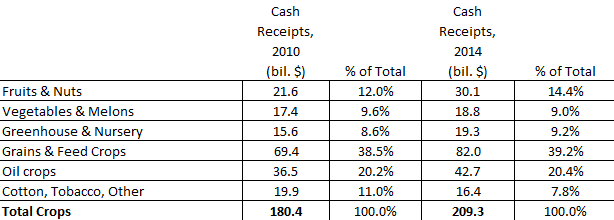Mechel S. Paggi indicated recently at Choices Magazine Online that, “The federal crop insurance program has been the focus of increased attention following its enhanced role in the farm safety net resulting from the 2014 Farm Bill (Zuluf and Orden, 2014). Most often that attention has been directed at coverage for crops associated with traditional federal farm support programs, such as corn, wheat and soybeans (Babcock, 2016). However, as some researchers have pointed out, crop insurance is also a risk management tool for U.S. specialty crop producers, such as, fruit, vegetables, tree nuts (Coble, 2016). According to the most recent U.S. Department of Agriculture, Risk Management Agency (USDA-RMA) report around 73% of the acres devoted to specialty crop production have been covered by federal crop insurance programs (Figure 1) (FCIC, 2015).”
Figure 1, Choices Magazine

The Choices article stated that, “Efforts by USDA-RMA to develop risk management programs for specialty crops were encouraged by the Federal Crop Insurance Reform and Department of Agriculture Reorganization Act of 1994. During the period 1995 to 2003 USDA-RMA had policies in place that covered 32 specialty crops with active pilot programs for an additional 30 crops (USDA- RMA, 2004). In their latest Specialty Crop Report to Congress, the USDA provides a list of 38 specialty crops that are currently covered by federal crop insurance plans (FCIC 2015).
“The 2014 Farm Bill continued the move toward enhancement of specialty crop insurance coverage. One example was the call for the development of a whole farm revenue protection policy tailored to specialty crop producers.”
Dr. Paggi noted that, “The value of U.S. farm cash receipts from the sale of fruits, tree nuts, vegetables, melons, greenhouse, and nursery was $68.2 billion in 2014 up from $54.6 billion in 2010 (Table 1). The value of specialty crops accounts for over 30% of the cash receipts for crop sales in the United States.”
Table 1, Choices Magazine

After additional analysis, the Choices article added that, “Crop insurance plays a valuable role for specialty crop producers in managing risk. There is increasing focus on improving U.S. consumers’ dietary habits by promoting increased consumption of fruits, vegetables, and tree nuts. Providing the producers who supply U.S. specialty crops with a risk management safety net will likely continue to be a farm policy priority. There have been substantial improvements in the coverage levels and products available in recent years. Additional progress will likely depend on the decisions of policy makers in the future as they struggle to allocate increasingly scarce budgetary resources.”

